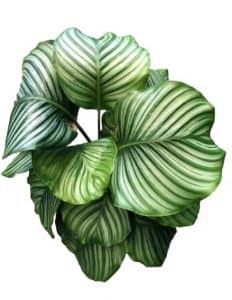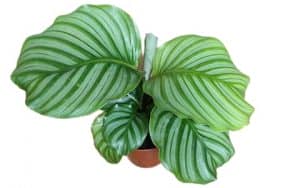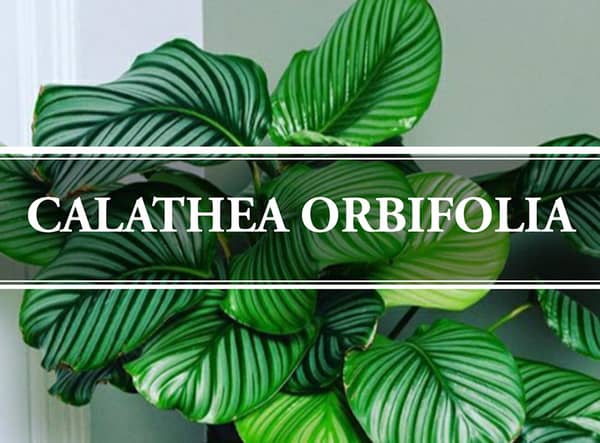Who would not love to have a non-toxic domestic plant with attractive foliage? The Calathea orbifolia is a flowering plant native to Bolivia. The big round leaves are subtly striped with green and silvery green patterns and silvery-green undersides. You can grow it outdoors as well as indoors. However, the bold foliage, air-purifying abilities, and non-toxic nature make it a desirable indoor plant. This exotic-looking Calathea is all enough to add the ‘necessary oomph’ in any simple room.
This rare plant is a little tricky to grow. So, it is not much recommendable for beginners and busy folks. Interesting? Let us know more about the Orbifolia Prayer plant along with its care and propagation.
Calathea Orbifolia Classification
Family: Marantaceae. (Arrowroot family)
Genus: Calathea.
Species: C. orbifolia
Genus Calathea
This is a vast genus comprising containing dozens of perennial flowering plants. These American natives are famous for their large, attractive, and brightly colored leaves. Calatheas can live both indoors and outdoors. However, they are quite popular as indoor plants to beautify the indoor surroundings.
The name of the genus is derived from the Greek word ‘Basket’. This refers to the large and spacious flowers of these plants.
Calathea Orbifolia Common Names
- Round-leaf plant.
- The Orbifolia Prayer plant.
Features of the Calathea Orbifolia Plant

Size
- On average, an indoor plant gets around 2 to 3 feet tall. On the other hand, outdoor growers get taller than indoor peeps.
- The round-shaped leaves get quite large on full development. A fully grown leaf is about 8 to 15 inches in length with a width of about 10 to 15inches in width.
Flowers
Just like other Calatheas, the plant produces flowers in the growing season. However, seeing them blooming indoors is quite rare.
Toxicity
Just like other Calatheas, the Orbifolia Plant is non-toxic for us and our pets. So, if you have naughty kids and pets with you, this plant is a nice choice for an indoor plantation.
Growth Rate
The Calathea orbifolia growth rate is moderate to slow.
Calathea Orbifolia Care
Calatheas are moisture-loving plants and need moist soil with high humidity. Moreover, unlike the majority of houseplants, these are not easy peeps. Thus, we generally don’t recommend them for beginners.
Water Requirement
Providing adequate water to this plant is a bit tricky. You need to keep the soil moist while avoiding overwatering. A simple strategy is to water generously until the water starts draining out from the base. Now, let the upper inch of the soil get partially dry before you water again.
As far as frequency is concerned, it depends upon the weather and season. You need to check the soil at the start to get an idea bout the soil. In summer, about twice a week is enough. However, in winter, reduce the watering to about once a week.
Make sure you are not over-watering and never keep them soggy. This is essential to avoid issues like fungus and root rot. Inadequate and overwatering both are clear from the plant’s appearance. Brownish dry edges are a possible sign that the plant needs more water. On the other hand, loose leaves and softer stems will eventually lead to root rot due to excess water.
Sunlight Requirement
These plants need bright to medium indirect light. You can place them indoors in north, west, or an east-facing window. It is better to avoid South facing windows as they may provide direct sunlight. These plants can survive in low light. However, at least 6 hours of bright to medium indirect light is essential for a bright appearance. In case you see the plant is getting pale, this could be due to over or underexposure to light.
Soil Requirement
Porous soil with good drainage is ideal for Calathea plants. The growing mixture should fulfill the unique ability to retain moisture without getting soggy. Moreover, it needs plenty of aeration.
You can use clay pebbles at the base of the soil or the growing mix. This results in enhanced moisture retention. Alternatively, pitting the decorative pebbles on top of the mixture decreases aeration.
In commercially prepared options, a peat-based mixture is suitable. On the other hand, two parts of peat with one part of perlite are suitable for domestic mixing.
Temperature Requirement
The optimum temperature range for the Orbifolia is between 18 to 24 °C. These plants have poor tolerance for cold and frost. Moreover, a temperature below 15 °C may affect the plant’s health negatively or may freeze it out totally. Thus, we recommend transferring the plant to warmer spots as soon as the fall arrives.
Humidity Requirement
These tropical plants like humidity. More than 50% of the moisture is suitable for the plant. On dry days, consider daily misting to maintain the moisture level. Moreover, you can go for other measures like introducing a humidifier or a pebble-water tray.
The heating systems in winters increase the dryness in the atmosphere. You can cope up with this issue with regular misting. So, the winters will require you to decrease watering the soil and increase the misting.
Fertilizer Requirement
Use a monthly dose of a house plant fertilizer in ¼ of the recommended strength. High nitrogen fertilizers show good results on this peep. This extra nutrition is only required in the growing days of spring and summer. Moreover, cold weather decreases the nutritional requirements of the plants. Thus, make sure you stop fertilizing in fall and winter.
Over-fertilization is harmful to this plant. Yellowing of leaf edges is a possible sign that you are over-feeding the plant baby.
Potting and repotting requirements
Use a medium-sized pot with drainage holes at the base. As far as repotting is concerned, you don’t need to do it frequently. Repot once the roots start coming out of the pot or the plant gets too big for the pot.
Pruning Requirement
You can cut the older and unhealthy leaves once in a while. This will help you to maintain the health and appearance of the plant.
Grooming Requirement
The striped leaves have a tendency to get covered with dust. Weekly cleaning with a piece of damp cloth will help you to keep the plant dust-free and healthy.
Growth Zone
The ideal USDA growth zones for outdoor plantations are 10 and 11.
Related Posts:
Calathea Orbifolia Propagation

You would love to get new Orbifolia plants from your existing ones. It is propagated by plant division. However, this Calathea is a little tricky in propagation.
Season
The ideal time to propagate the round-leaf Calathea plant starts around the middle of the
Method
- Take a mature healthy plant and remove it gently out of the soil. Shake off any excess soil attached to the roots.
- Divide the roots segments for growing new plants. Make sure there are at least a few stems and leaves on each segment.
- Plant each part in the moist growing mixture. This mix should be well-drained and aerated as mentioned in the previous section. The depth of each plant should be the same as the parent plant.
- Cover each pot with a polythene bag or a plastic cover. This will help to maintain the moisture for the growing plant. Now, place the whole setups in low indirect light.
- Roots will get strong and start developing in the new place after around 3 weeks.
- Remove the cover after about 1 month. The growth of tiny shoots will show your success in the propagation.
- You can transfer the plant in bright to medium indirect sunlight once it starts growing. However, it is important to introduce the plant to bright light in repeated episodes of short exposures. At this stage, simply follow the Calathea orbifolia Care mentioned in the previous section and enjoy the development of this beauty.
Summary
Calathea Orbifolia is a flowering plant native to the tropical regions of Bolivia. The attractive foliage is enough to decorate any corner. The big and round green leaves with silvery green strips and silver-green undersides make it an absolute eye candy.
The plant produces beautiful flowers which are rarely seen in the indoor plantation. The Calathea orbifolia Care includes moist soil, high humidity, and indirect light of medium intensity.
It is important to mention here that this Calathea is a bit tricky to grow. So, it is not an ideal choice for beginners. Besides the beautiful appearance, the plant provides the added benefits of air purification. Moreover, it is non-toxic and safe to be around kids and pets.

